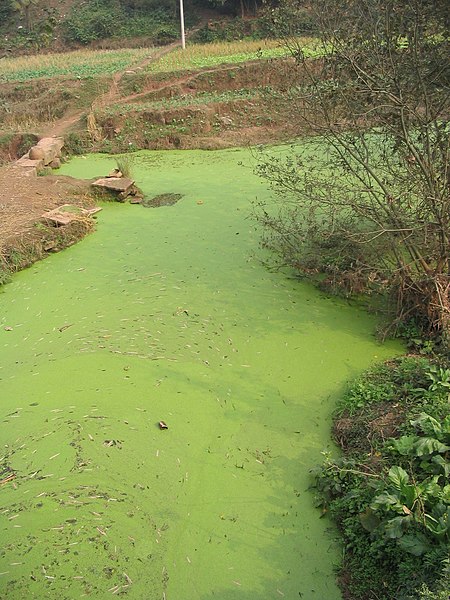The first time I visited Portland, probably 5 or 6 years ago, I came across a very nicely designed bioswale at St. Philip Neri Parish in South East. A bioswale is a specially designed stormwater catch basin with plants in it that collects and helps manage runoff. They're nice landscape features in urban places. Most people have never given it much thought, but cleaning and managing stormwater runoff with bioswales is a good idea for a few reasons.
Ok, now ignore the picture above. Picture an urban hardscape. When it rains, what happens to the water that hits your house, your sidewalks, your streets, and your parking lots? It runs off the hardscape into the gutter, right? And from there, the ordinary approaches are pretty simple. Gutters send the runoff into the city's stormwater systems, and those tend to either lead to a part of the sewage system or to simply direct the water away. "Away" tends to mean roadside ditches in less developed areas, rivers, lakes, beaches, whatever. These approaches have significant problems.
First, just directing it away doesn't slow it down. In your picture of an urban hardscape, I imagine there wasn't a lot of grass or wetlands. Part of that may be because I used the word "hardscape," but even suburban lawns don't really do the trick when so much area is covered by houses, streets, and sidewalks. Water flows over urban spaces in gravity-powered sheets of erosive energy. All the stormwater system does is gather it all into one narrow space where it can do an incredible amount of harm.
When all that unnaturally fast-flowing water finally makes it to an outfall, out to daylight again, if it isn't straight into a body of water, it cuts through the topography like a knife. Any vegetation, native or otherwise, that might slow down or benefit from normal water flow gets torn away. What you end up with often looks like Paul Bunyan took his axe to the side of a hill, or gouged it across a meadow. Trees can't stabilize an area against that energy; they get undercut and they fall in.
If the outfall does lead directly to a body of water, you still have problems. That runoff isn't just water, it's motor oil, dirt, silt, windshield wiper fluid, dripped gasoline, soap residue from washing your car in the driveway, and a hundred other chemicals. Testing has shown that our highway system is a network of thoroughly lead-contaminated corridors. The weights your mechanic puts on your rims to balance your wheels are lead, the paint on old white-wall tires was lead-based for decades, and that nastiness (plus a whole lot more) has built up in roadside dust since the beginning of American car culture. And every time it rains, a portion of that filth gets directed right to where you, your neighbor, your uncle, or your co-worker likes to go fishing.
Where I grew up, they tended to use the sewage route tactic. So whenever it rained enough, the sewage treatment system got a huge load of extra water, often more than it could handle, and it sometimes overflowed the sewage treatment facilities. This overflow was just directed out to the beach. There were annual blooms of fecal coliform bacteria in the coastal waters, and yes, that is exactly what it sounds like. And then they still had erosion problems at the outfalls a lot of the time.
A river full of poo-slime
Bioswales, though, catch that water and slow it down by design; they're shaped for retention and slow discharge. While the water sits there, the sediments and a good deal of the contaminants can drop out in a confined, maintained, cleanable space, rather than getting sent "away." The hardy, native plant species adapted to the region, also slow water flow, and get something like an inundated wetland habitat for a time. In addition, the plants themselves are chosen for their ability to take up and/or filter out a lot of contaminants, including oil. Once all this has happened, the water flows into the stormwater system clean and slow.
So bioswales are important because they lighten and spread out the load on stormwater and sewage systems over time to reduce overflows, they recharge the groundwater, and they clean the runoff before it even gets into the system. All of that is aside from the fact that they can also be very pretty, and make me feel proud of my town for its forward-thinking development. I was lucky enough to have the opportunity to go volunteer at a planting in a rather large bioswale adjacent to the Willamette Park boat ramp, recently, and got a few really nice photos.
Me & the kiddos volunteering
Yes, this is another "I love Portland" post. See, Portland has these things all over the place. They're outside my grocery store, in front of houses, and on major thoroughfares. There's actually a suggested bicycle route you can take to check out a large number of them on the east side of town. Portland even has a volunteer group that goes around taking care of these things, picking up trash that gets washed into them, raking up leaves that'd otherwise clog the drain, or even watering the plants in the dry season to help them thrive.
The volunteer Green Street Stewards program has a maintenance guide and formal training events. There are two trainings left this season (one morning session on the 29th of this month in SE, one evening session on the 3rd of next month in NE), and they need all the help they can get. Go sign up. Do some good for your wonderful City, and feel good about investing in your town.






